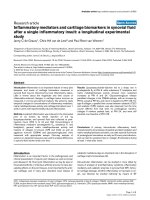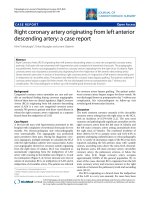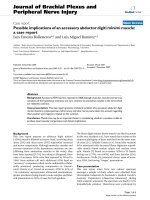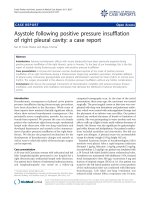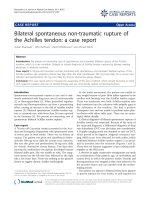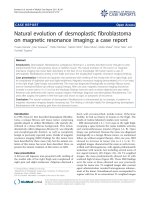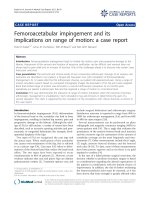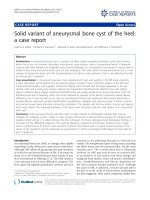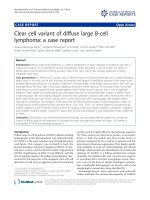Báo cáo y học: "Chemical pneumonitis and subsequent reactive airways dysfunction syndrome after a single exposure to a household product: a case report" pptx
Bạn đang xem bản rút gọn của tài liệu. Xem và tải ngay bản đầy đủ của tài liệu tại đây (557.54 KB, 6 trang )
BioMed Central
Open Access
Page 1 of 6
(page number not for citation purposes)
Journal of Medical Case Reports
Case report
Chemical pneumonitis and subsequent reactive airways
dysfunction syndrome after a single exposure to a household
product: a case report
Imran Khalid*
1
, Amanda M Godfrey
2
and Daniel R Ouellette
2
Address:
1
Consultant, Department of Critical Care, King Faisal Specialist Hospital & Research Center, Jeddah, Saudi Arabia and
2
Division of
Pulmonary and Critical Care Medicine, Henry Ford Hospital, W Grand Boulevard, Detroit, Michigan, 48202, USA
Email: Imran Khalid* - ; Amanda M Godfrey - ; Daniel R Ouellette -
* Corresponding author
Abstract
Introduction: Household products are usually safe to use. Adverse events arising from their use
are mostly reported in patients with pre-existing atopy or pulmonary problems and usually only
after a prolonged exposure to such products. We report the case of a patient with no prior
problems who developed significant side effects from a single exposure to a domestic product.
Case presentation: A 43-year-old Caucasian American man, previously in good health, used a
domestic aerosol product called 'Stand N' Seal "Spray-On" Grout Sealer' in an enclosed room in
his house. The product contained n-butyl acetate (<5%), propane (10%), isobutane (<5%), C8-C9
petroleum hydrocarbon solvent (80%), a fluoropolymer resin and a solvent. Within a few hours of
exposure to the sealant, he developed rapidly progressive shortness of breath and a severe non-
productive cough. By the time he reached the emergency room he was severely hypoxic. A
diagnosis of chemical pneumonitis was made based on the clinical scenario and the diffuse infiltrates
on the computer tomography scan. With supportive therapy, his condition improved and he was
discharged from the hospital. However, he continued to have symptoms of intermittent cough and
shortness of breath in response to strong odours, fumes, cold air and exertion even after his chest
radiograph had normalized. Three months later, bronchial hyper-responsiveness was documented
by a methacholine inhalation test and a diagnosis of reactive airways dysfunction syndrome was
made. The patient was started on high-dose inhaled steroids and his symptoms improved. The
mechanism of toxicity and determination of the exact agent responsible is still under investigation.
Conclusion: A household product may still prove unsafe to use even after it has gone through
vigorous testing and approval processes. Even healthy individuals are susceptible to adverse
outcomes after a brief exposure. Extra precautions should be taken when using any chemical
product at home.
Introduction
Household products are usually safe to use. Adverse respi-
ratory events are most commonly experienced by patients
with pre-existing atopy or pulmonary problems, and usu-
ally after a prolonged exposure to these products [1-5].
Cleaning agents, particularly bleach, are the most com-
Published: 9 November 2009
Journal of Medical Case Reports 2009, 3:112 doi:10.1186/1752-1947-3-112
Received: 19 September 2009
Accepted: 9 November 2009
This article is available from: />© 2009 Khalid et al; licensee BioMed Central Ltd.
This is an Open Access article distributed under the terms of the Creative Commons Attribution License ( />),
which permits unrestricted use, distribution, and reproduction in any medium, provided the original work is properly cited.
Journal of Medical Case Reports 2009, 3:112 />Page 2 of 6
(page number not for citation purposes)
mon culprits [2,3,5]. We report here, however, a case of a
patient with no prior health problems who developed sig-
nificant side effects from a single exposure to a domestic
product, a grout sealer. To the best of our knowledge, this
is the first case where a patient developed chemical pneu-
monitis and subsequent reactive airways dysfunction syn-
drome (RADS) from the combination of specific
ingredients contained in this product.
Case presentation
A 43-year-old Caucasian American man, who was a
smoker but had no subjective or objective evidence of pul-
monary disease or atopy, was in good health until he used
a domestic aerosol product called 'Stand N' Seal "Spray-
On" Grout Sealer' in an enclosed room in his house.
Within a few hours of exposure to this sealant, he devel-
oped rapidly progressive shortness of breath and a severe
non-productive cough. He did not have any associated
chest pain or fever. His examination at our Emergency
Department revealed a blood pressure of 155/89 mmHg,
a heart rate of 126/minute, a respiratory rate 24/minute
and a temperature of 37.2°C. No cyanosis, clubbing or
edema was found. Lung auscultation revealed diminished
air entry and inspiratory bilateral rales. A basic laboratory
work-up showed normal results, including normal cell
count differential.
An electrocardiogram showed sinus tachycardia without
any other abnormality. An arterial blood gas on room air
demonstrated a PO
2
of 32.7 mmHg and oxygen saturation
of 67.2%, which improved to 85.2 mmHg and 97.4%,
respectively, with 100% inspired oxygen. A chest X-ray
and computer tomography of the patient were also
obtained (Figures 1 and 2).
The patient was initially admitted to the intensive care
unit to treat his chemical pneumonitis. He was initially
treated with oxygen, albuterol nebulization and intrave-
nous high-dose methylprednisolone, which was then fol-
lowed by oral dexamethasone (10 mg every 8 hours). His
condition improved in a few days. Upon discharge, he did
not require oxygen. His respiratory symptoms had
improved and he was instructed to take a 10-day course of
oral prednisone.
The patient went to our pulmonary clinic one week after
being discharged. He noted a definitive improvement in
his symptoms but said that he was still experiencing inter-
mittent wheezing and chest tightness, which could be alle-
viated by inhaling albuterol. He reported that he had not
smoked tobacco since his hospitalization. A second chest
X-ray yielded a normal result. A pulmonary function test-
ing (PFT) showed reduced lung volumes and mild reduc-
tion in the patient's single-breath diffusion capacity for
carbon monoxide (DLCO). He did have a significant
bronchodilator response to albuterol (320 ml and 13%
improvement in FEV1 (forced expiratory volume in 1 sec-
ond)).
The patient returned for follow-up one month after pres-
entation with complaints of an intermittent cough and
Chest radiographFigure 1
Chest radiograph. Chest X-ray showing bilateral air-
space disease.
Computed tomographic (CT) scanFigure 2
Computed tomographic (CT) scan. Non-contrast CT
scan showing diffuse bilateral ground-glass opacities.
Journal of Medical Case Reports 2009, 3:112 />Page 3 of 6
(page number not for citation purposes)
shortness of breath in response to strong odours, fumes,
cold air and exertion. He had not smoked tobacco since
his hospital discharge. He then underwent cardiopulmo-
nary exercise testing, which showed no ventilatory
mechanical limitation, gas exchange abnormality or diffu-
sion impairment. At about 3 months after his initial expo-
sure to the cleaning product, the patient underwent a
methacholine challenge test (MCT), which demonstrated
a 22% decrease in his FEV
1
level from 2.80 liters to 2.19
liters following the administration of methacholine at a
concentration of 1 mg/ml. A diagnosis of reactive airways
dysfunction syndrome (RADS) was thus made, as our
patient fulfilled the seven diagnostic criteria for RADS [6].
The patient was started on inhaled fluticasone and salme-
terol. His cough and shortness of breath in response to
strong odours, fumes, cold air and exertion showed a slow
but steady improvement. His PFT showed a gradual
improvement in flows (Figure 3). Six months after the ini-
tial exposure to the chemical, the patient had a repeat
MCT and his FEV
1
decreased from 2.75 litres to 2.33 litres
(21% reduction). However, the concentration of metha-
choline, which had to achieve a positive test, was now 4
mg/ml as opposed to the 1 mg/ml on the initial MCT (Fig-
ure 4). He was made to continue his therapy until his
bronchial reactivity is resolved.
Discussion
Household products are usually declared safe to use after
they pass appropriate testing conducted by responsible
agencies. Most of the studies on cases where patients have
developed respiratory complaints after exposure to
inhaled domestic products show that the conditions
develop in patients with pre-existing lung problems or
atopy [1-4]. Symptoms of asthma exacerbation, chronic
bronchitis, bronchial hyper-responsiveness and acute res-
piratory distress syndrome have been reported in such
patients [1-3]. One particular study shows that house-
wives can develop RADS after their continued exposure to
bleach (40% sodium hypochlorite and 18% hydrochloric
acid) [5]. However, the development of severe chemical
pneumonitis and subsequent RADS in an individual who
Graph showing changes in pulmonary function testing with time after the initial exposureFigure 3
Graph showing changes in pulmonary function testing with time after the initial exposure. FEV1: forced expira-
tory volume in 1 second; FVC: forced vital capacity.
Journal of Medical Case Reports 2009, 3:112 />Page 4 of 6
(page number not for citation purposes)
has no pre-existing lung condition and had been exposed
only once to the component combination of this house-
hold product, has not been reported before.
Chemical pneumonitis has been reported after exposure
to a variety of industrial chemicals and respiratory irri-
tants. The treatment is usually supportive, although ster-
oids have been administered during the acute phase after
exposure. RADS is a nonimmunologic asthma-like syn-
drome resulting from a high level of exposure to an irri-
tant gas, smoke, fume or vapour either at home, at the
workplace or in the general environment [6,7]. The inci-
dence of developing RADS after an inhalational exposure
to an irritant substance has been difficult to quantify
because patient-specific information on the magnitude
and duration of exposure at the time of an inhalational
accident is often not available.
The pathogenesis of RADS, particularly the persistence of
the asthmatic state, is based on speculation. One hypoth-
esis is that extensive inflammation associated with short-
term exposure may alter receptor thresholds in the air-
ways, thus resulting in non-specific bronchial hyperreac-
tivity [7,8]. Other hypotheses involve direct damage to the
bronchial mucosa and the release of mediators altering
smooth muscle responsiveness, both eventually causing
bronchial hyper-reactivity [7,8]. The pathologic features
of RADS have also been difficult to define as data from
serial bronchial biopsies starting at the time of exposure
are limited. One case report describes serial histopatho-
logic bronchial alterations of up to 5 months after chlo-
rine inhalation, demonstrating that the histopathologic
abnormalities are partially reversible [9].
Risk factors contributing to the development of RADS are
also not well defined. In highly exposed rescue workers at
the World Trade Center in New York, USA, bronchial
hyper-reactivity at 1 and 3 months post-exposure was the
sole significant predictor for the development of RADS
[10]. In addition, increased concentrations of offending
agents and wet aerosols are said to enhance the probabil-
ity of developing RADS [11]. Management of patients
with established RADS is based on minimal evidence.
Many patients have been treated initially with oral corti-
Graph showing changes in methacholine challenge testing with time after the initial exposureFigure 4
Graph showing changes in methacholine challenge testing with time after the initial exposure. FEV1: forced
expiratory volume in 1 second.
Journal of Medical Case Reports 2009, 3:112 />Page 5 of 6
(page number not for citation purposes)
costeroids, which were then followed by high-dose
inhaled corticosteroids. Serial monitoring of bronchial
hyper-reactivity is often advocated. Tapering of the
inhaled corticosteroids is usually based on the clinical
response to the treatment. The response to treatment is
variable and the condition may take months or years to
resolve [12].
The United States Consumer Product Safety Commission
recalled 'Stand N' Seal "Spray-On" Grout Sealer' after
receiving 88 reports of adverse reactions that developed
following the use of this aerosolized sealant. The Com-
mission report stated that the product's odour was not
chemically pungent enough to force consumers to mini-
mize their exposure to the fumes. A total of 28 individuals
sought medical attention for respiratory symptoms before
the product was recalled and 13 required medical treat-
ment (Office of Information and Public Affairs. CPSC,
Tile Perfect, Inc.: Announce Recall of Stand N' Seal Grout
Sealer Due to Respiratory Problems. U.S. Consumer Prod-
uct Safety Commission, 08/31/2005; Washington, DC.).
'Stand N' Seal "Spray-On" Grout Sealer' is composed of
D-
limonene, n-butyl acetate (<5%), propane (10%), isobu-
tane (<5%) and C8-C9 petroleum hydrocarbon solvent
(80%) (Tile Perfect, Inc. Stand N Seal Spray On Grout.
Material Safety Data Sheet. 05/31/2005, Aurora, IL.).
However, there appears to have been an alteration in the
grout sealer's original composition when a different fluor-
opolymer and solvent were used, causing the allegation
that the fluoropolymer resin may have actually caused the
symptoms. The mechanism of toxicity and determination
of the exact agent responsible, however, is still under
investigation. The agents most frequently associated with
the development of RADS include chlorine, toluene di-
isocyanate and oxides of nitrogen [13]. Fluoropolymer
inhalation can also cause acute pulmonary toxicity [14]. It
is not evident which toxic substance led to the develop-
ment of RADS in our patient, but fluoropolymers, isobu-
tane and C8-C9 petroleum hydrocarbon solvent can all
cause respiratory irritation [14,15].
Conclusion
To the best of our knowledge, this may be the first official
documentation of a patient developing chemical pneu-
monitis with subsequent RADS after a single exposure to
the components of this specific sealer. The product lacked
a pungent odour, which probably resulted in over-expo-
sure to the vapours (Office of Information and Public
Affairs. CPSC, Tile Perfect, Inc.: Announce Recall of Stand
N' Seal Grout Sealer Due to Respiratory Problems. U.S.
Consumer Product Safety Commission, 08/31/2005;
Washington, DC.). However, whether it was a specific pol-
ymer in the product, a specific solvent or a mixture that
caused the symptoms, needs to be further evaluated to
avoid potential complications arising from the use of sim-
ilar products. In the meantime, it is important to take pre-
cautions when using chemical products at home as
household products may not be totally safe even after
going through vigorous testing and approval processes.
Abbreviations
DLCO: diffusion capacity for carbon monoxide; FEV1:
forced expiratory volume in 1 second; PFT: pulmonary
function testing; MCT: methacholine challenge test;
RADS: reactive airways dysfunction syndrome.
Consent
Written informed consent was obtained from the patient
for publication of this case report and any accompanying
images. A copy of the written consent is available for
review by the Editor-in-Chief of this journal.
Competing interests
The authors declare that they have no competing interests.
Authors' contributions
IK wrote the case report portion of the manuscript. AMG
wrote the discussion. DRO made critical revisions to the
whole manuscript. All authors read and approved the
final manuscript.
References
1. Henderson J, Sherriff A, Farrow A, Ayres JG: Household chemi-
cals, persistent wheezing and lung function: effect modifica-
tion by atopy? Eur Respir J 2008, 31:547-554.
2. Medina-Ramón M, Zock JP, Kogevinas M, Sunyer J, Torralba Y, Borrell
A, Burgos F, Antó JM: Asthma, chronic bronchitis, and expo-
sure to irritant agents in occupational domestic cleaning: a
nested case-control study. Occup Environ Med 2005, 62:598-606.
3. Mapp CE, Pozzato V, Pavoni V, Gritti G: Severe asthma and ARDS
triggered by acute short-term exposure to commonly used
cleaning detergents. Eur Respir J 2000, 16:570-572.
4. Anderson RC, Anderson JH: Respiratory toxicity of fabric sof-
tener emissions. J Toxicol Environ Health A 2000, 60:121-136.
5. Gorguner M, Aslan S, Inandi T, Cakir Z: Reactive airways dysfunc-
tion syndrome in housewives due to a bleach-hydrochloric
acid mixture. Inhal Toxicol 2004, 16:87-91.
6. Tarlo SM, Balmes J, Balkissoon R, Beach J, Beckett W, Bernstein D,
Blanc PD, Brooks SM, Cowl CT, Daroowalla F, Harber P, Lemiere C,
Liss GM, Pacheco KA, Redlich CA, Rowe B, Heitzer J: Diagnosis and
management of work-related asthma: American College Of
Chest Physicians Consensus Statement. Chest 2008, 34(3
Suppl):1S-41S.
7. Brooks SM, Weiss MA, Bernstein IL: Reactive airways dysfunction
syndrome (RADS). Persistent asthma syndrome after high
level irritant exposure. Chest 1985, 88:376-384.
8. Alberts WM, do Pico GA: Reactive Airways Dysfunction Syn-
drome. Chest 1996, 109:1618-1626.
9. Lemiere C, Malo J-L, Boutet M: Reactive airways dysfunction syn-
drome due to chlorine: sequential bronchial biopsies and
functional assessment. Eur Resp J 1997, 10:241-244.
10. Banauch GI, Alleyne D, Sanchez R, Olender K, Cohen HW, Weiden
M, Kelly KJ, Prezant DJ: Persistent hyperreactivity and reactive
airway dysfunction in firefighters at the World Trade
Center. Am J Respir Cri Care Med 2003, 168:54-62.
11. Kern DG: Outbreak of the reactive airways dysfunction syn-
drome after a spill of glacial acetic acid. Am Rev Respir Dis 1991,
144:1058-1064.
12. Malo JL, Cartier A, Boulet LP, L'Archeveque J, Saint-Denis F, Bherer
L, Courteau JP: Bronchial hyperresponsiveness can improve
while spirometry plateaus two to three years after repeated
Publish with BioMed Central and every
scientist can read your work free of charge
"BioMed Central will be the most significant development for
disseminating the results of biomedical research in our lifetime."
Sir Paul Nurse, Cancer Research UK
Your research papers will be:
available free of charge to the entire biomedical community
peer reviewed and published immediately upon acceptance
cited in PubMed and archived on PubMed Central
yours — you keep the copyright
Submit your manuscript here:
/>BioMedcentral
Journal of Medical Case Reports 2009, 3:112 />Page 6 of 6
(page number not for citation purposes)
exposure to chlorine causing respiratory symptoms. Am J
Respir Crit Care Med 1994, 150:1142.
13. Shakeri MS, Dick FD, Ayres JG: Which agents cause reactive air-
ways dysfunction syndrome (RADS)? A systematic review.
Occup Med 2008, 58:205-211.
14. Lazor-Blanchet C, Rusca S, Vernez D, Berry R, Albrecht E, Droz PO,
Boillat MA: Acute pulmonary toxicity following occupational
exposure to a floor stain protector in the building industry in
Switzerland. Int Arch Occup Environ Health 2004, 77:244-248.
15. Rohrig TP: Sudden death due to butane inhalation. Am J Forensic
Med Pathol 1997, 18:299-302.
